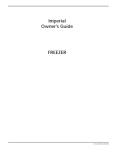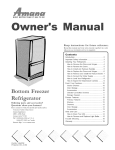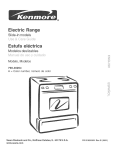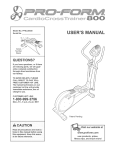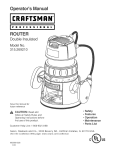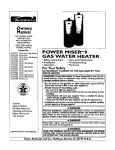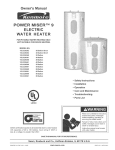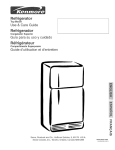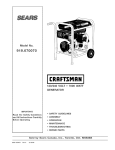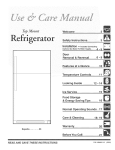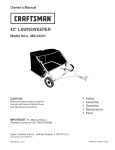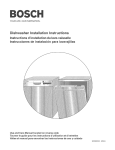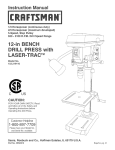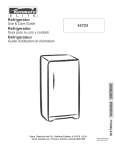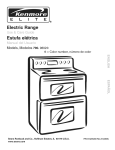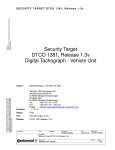Download Kenmore 11012502100 Washer User Manual
Transcript
®
Side by Side Refrigerator
Use & Care Guide
Lado a Lado Refrigerador
Gufa para su uso y cuidado
Compartiments
C6te _ C6te R_frig_rateur
Guide d'utilisation et d'entretien
Z
M
t_
Sears, Roebuck and Co., Hoffman Estates, IL 60179 U.S.A.
Sears Canada, mnc., Toronto, Ontario, Canada M5B 2B8
www,seats,com
241579602
(0410)
Welcome &
Congratulations
Important Safety
Instructions
Congratulations on your purchase of a new refrigerator! We
here at Sears are very proud of our product and we are
completely committed to providing you with the best
service possible, Your satisfaction is our #1 priority,
Please Read AJJInstructions
UsingThis Refrigerator.
FOR YOUR
o
This Owner's Guide provides specific operating
instructions for your model, Use your refrigerator only as
instructed in this manual, These instructions are not meant
to cover every possible condition and situation that may
occur, Common sense and caution must be practiced
when installing, operating and maintaining any appliance,
Ptease record your model and seriaJ numbers below
for future reference.This
information is found on the
sedal pJate located inside the refrigerator
compartment.
SAFETY
Do not store or use gasoline, or other flammable liquids
in the vicinity of this or any other appliance, Read product
labels for warnings regarding flammability and other
hazards,
We know you'll enjoy your new refrigerator and ThankYou
for choosing our product, We hope you consider us for
future purchases,
PLEASE READ AND SAVE THESE
iNSTRUCTiONS
Before
Do not operate the refrigerator in the presence of
explosive fumes,
Avoid contact with any moving parts of automatic ice
maker,
Remove all staples from the carton, Staples can cause
severe cuts, and also destroy finishes if they come in
contact with other appliances or furnitu re,
CHILD
SAFETY
Destroy or recycle the carton, plastic bags, and any
exterior wrapping material immediately after the refrigerator
is unpacked, Children should NEVER use these items to
play, Cartons covered with rugs, bedspreads, plastic
sheets or stretch wrap may become airtight chambers,
and can quickly cause suffocation,
Model Number: 253
PROPER
DISPOSAL
OR FREEZER
or:
Serial Number:
REFRmGERATOR
Risk of child entrapment
Purchase Date:
TABLE
OF CONTENTS
Record SefiaU/Model
Numbers
............ 2
Safety ..................................................
Warranty ..............................................
Protection Agreements ........................
installation ...........................................
2-3
3
4
5-6
Door Removal Instructions
.................
Features At A GRance .........................
7
8
Temperature ControUs ..........................
Looking Inside .....................................
Automatic Ice & Water Dispenser .......
Front Ice and Water FHter ....................
9
10=12
13=15
16
Food Storage
OF YOUR
& Energy Saving Tips ... 17
Normal Operating Sounds & Sights .... 18
Care & Cleaning ..................................
19o20
Before You Call ....................................
21-24
Child entrapment and
suffocation are not problems of
the past, Junked or abandoned
refrigerators or freezers are still
dangerous - even if they will sit
for "just a few days," if you are
getting rid of your old refrigerator
or freezer, please follow the
prevent accidents,
Before you throw away your old refrigerator/freezer:
Remove doors,
Leave shelves in place so children may not easily climb
inside,
o
Have refrigerant removed by a qualified service
technician,
KENMORE
These Guidelines
Safety Mechanisms
Properly.
ELECTRICAL
*
*
Must Be FoHowedTo EnsureThat
InThis Refr!gerat0rW!lJ Operate
iNFORMATiON
The refrigerator must be plugged into its own
dedicated ! 15 VoJt, 60 Hz., AC only etectric outlet.
The power cord of the appliance is equipped with a
three-prong grounding plug for your protection against
electrical shock hazards, it must be plugged directly
into a properly grounded three=prong receptacle, The
receptacle must be installed in accordance with local
codes and ordinances, Consult a qualified electrician,
Do not use an extension cord or adapter plug.
Immediately repair or replace any power cord that
becomes frayed or damaged,
Never unplug the refrigerator by pulling on the power
cord, Always grip the plug firmly, and pull straight out
from the receptacle to prevent damaging the power cord,
Unplug the refrigerator before cleaning and before
replacing a light bulb to avoid electrical shock,
Performance may be affected if the voltage varies by
10% or more, Operating the refrigerator with insufficient
power can damage the compressor, Such damage is
not covered under your warranty,
Do not plug the unit into an outlet controlled by a wall
switch or pull cord to prevent the refrigerator from being
Avoid connecting refrigerator to a Ground Fault Interruptor
(GFi) circuit,
IMPORTANT: Turning the Freezer and Fresh Food
Controls to "0" turns oll the compressor and prevents
your refrigerator from cooling, but does not disconnecl
the power to the light bulb and other electrical
components. To turn off power to your refrigerator, you
must unplug the power cord from the wall receptacle.
Grcunding [ype
wamlrecectade
.t-
Do not. under
any
circutnstanccs,
cut, remove,
or bypass the
grounding
prong.
Power cord with
3-prcng groundcd
pmug
_.
ONE YEAR
REFRIGERATOR
FULL WARRANTY
WARRANTY
ON
REFRIGERATOR
For one year from the date of purchase, when this
refrigerator is operated and maintained according to
the instructions supplied with it, Sears will repair this
refrigerator, free of charge, if defective in material or
workmanship. This one year time period does not
include the refrigerator water filter cartridge (if
equipped), which is an expendable part warranted for
only 30 days (see below).
FIVE YEAR
FULL WARRANTY
REFRIGERATION
ON SEALED
SYSTEM
For five years from the date of purchase, when this
refrigerator is operated and maintained according to
the instructions supplied with it, Sears will repair the
sealed system (consisting of refrigerant, connecting
tubing, and compressor), free of charge, if defective
in material or workmanship.
30 DAY FULL WARRANTY
CARTRIDGE
ON WATER
FILTER
(if equipped)
For thirty days from the date of purchase, Sears will
replace the refrigerator water filter cartridge if it is
defective in material or workmanship.
All above warranty coverage applies only to
refrigerators which are used for storage of food for
private household pu rposes.
Warranty service is available in the United States or
Canada by contacting Sears at 1-800-4-MY-HOME ®
(1-800-469-4663).
This warranty applies only while this product is in use
in the United States or Canada. This warranty gives
you specific legal rights, and you may also have other
rights which vary from state to state or province to
province.
Sears, Roebuck and Co., Dept. 817WA, Hoffman
Estates, IL 60179
Sears Canada Inc., Toronto, Ontario, Canada M5B 2B8
In the U.S.A.
In Canada
Master Protection Agreements
Maintenance Agreements
Congratulations on making a smart purchase. Your
new Kenmore ®product is designed and manufactured
for years of dependable operation. But like all
products, it may require preventive maintenance or
repair from time to time. That's when having a Master
Protection Agreement can save you money and
aggravation.
Your purchase has added value because you can
depend on Sears HomeCentral ®for service. With over
2400 Service Technicians and more than a million
parts and accessories, we have the tools, parts,
knowledge and skills to back our pledge:
We Service What We Sell.
Purchase a Master Protection Agreement now and
protect yourself from unexpected hassle and expense.
The Master Protection Agreement also helps extend
the life of your new appliance. Here's what's included
in the Agreement:
Your Kenmore ®product is designed, manufactured
and tested to provide years of dependable operation.
But like all products, it may require service from time to
time. The Sears Maintenance Agreement offers you an
outstanding service program, affordably priced.
The Sears Maintenance Agreement
_"
Expert service by our 12,000 professional repair
specialists
•
_(
Unlimited service and no charge for parts and
labor on all covered repairs
•
•"
"No-lemon" guaranteereplacement of your
covered product if four or more product failures
occur within twelve months
•
_(
Product replacement if your covered product
can't be fixed
_"
Annual Preventive Maintenance Check at your
request - no extra charge
_(
Fast help by phone - phone support from a
Sears technician on products requiring in-home
repair, plus convenient repair scheduling
•"
Power surge protection against electrical
damage due to power fluctuations
_"
Rental reimbursement if repair of your covered
product takes longer than promised
Once you purchase the Agreement, a simple phone
call is all that it takes for you to schedule service. You
can call anytime day or night, or schedule a service
appointment online.
Sears has over 12,000 professional repair specialists,
who have access to over 4.5 million quality parts and
accessories. That's the kind of professionalism you
can count on to help prolong the life of your new
purchase for years to come. Purchase your Master
Protection Agreement today!
Some limitations and exclusions apply. For prices
and additional information,
call 1-800-827-6655.
Sears Installation Service
For Sears professional installation of home appliances
and items like garage door openers, water heaters,
and other major home items, in the U.S.A. call
1-800-4MY-HOM E®.
•
Is your way to buy tomorrow's service at today's
price.
Eliminates repair bills resulting from normal wear
and tear.
Provides phone support from a Sears technician
on products requiring in-home repair.
Even if you don't need repairs, provides an annual
Preventive Maintenance Check, at your request, to
ensure that your product is in proper running
condition.
Some limitations apply. For more information
about concerning Sears Canada Maintenance
Agreements, call 1-800-361-6665.
This Owner's Guide provides specific operating
instructions for your model. Use the refrigerator only as
instructed in this Use & Care Manual. Before starting the
refrigerator, foltow these important first steps.
LOCATION
Choose a place that is near a grounded electrical outlet.
Do Not use an extension cord or an adapter plug.
if possible, place the refrigerator out of direct sunlight
and away from the range, dishwasher or other heat
sources.
The refrigerator must be installed on a floor that is level
and strong enough to support a fully loaded refrigerator.
Consider water supply availability for models equipped
with an automatic ice maker.
mNSTALLATION
To Install Toe Griiie:
1,
fresh food
Cabinet
DO Not install the tefrigeratorwhere
2_
the temperature will drop below 55°F (130C) or rise
above 110_F (43°C), The compressor w!H not be aMe
tO maintain
proper temperatures
inside the
Line up toe grille at
base of refrigerator,
making sure the four
bottom tabs are
resting through hobs
at base of cabinet.
lower front of your refr!gerator.Sufficient air Circulat!on
is essential
for the proper operation
of your
Installation
o
Clearances
Allow the following clearances for ease of installation,
proper air circulation, and plumbing and electrical
connections:
Sides & Top
Back
DOOR
3,
3/8"
1"
OPENING
Starting from left side
of toe grille, press in on first top tab using your thumb
and push toe grille forward until it snaps in place. Continue
this process until all tabs aresnapped in place and toe
grille is secured to refrigerator.
All four corners of your refrigerator must rest firmly on a
solid
floor,
Your
refrigerator
isequipped
with
adiustable
front rollers to help level your unit. To ensure proper door
seal
and
assist
door
closing,
the
refrigerator
should
be
tilted 1/4" (6 mm), front to back.
To Level Your Refrigerator:
side against a wall, you may have to a!!ow additional
space so the door can be opened wider.
1,
2,
Your refrigerator should be positioned to allow easy access
to a counter when removing food. For best use of drawers
and freezer baskets, the refrigerator should be in a
position where both the refrigerator and freezer doors can
be fully opened.
TOE GRILLE
INSTALLATION
Remove toe grille, (See "To Remove Toe Grille",)
Use flat-blade screwdriver or 3/8" socket wrench
to adjust front rollers.
/ REMOVAL
To Remove Toe Grii/e:
1.
2.
Open freezer and fresh food compartment doors.
Working from left side of toe grille, slip your fingers between
top of toe grille and cabinet. Gently pull forward until firstset of
tabs are free. Slide your hand down past the free tabs and pull
forward again until the second set of tabs are free. Continue
this process until all tabs are free and the toe grille can be
removed. (See graphic at top of page in rightcolumn.)
3.
Check both doors to be sure seals touch cabinet on all
four sides.
_:E
i sta/latiofl
° connecting
@e Maker
To Water Supply
To avoid electric shock, which can cause death or severe personal injury, disconnect the refrigerator
from electricaJ power before connecting a water supply line to the refrigerator.
To Avoid Property Damage:
o
Copper tubing is recommended for the water supply line.Water supply tubing made of 1A"pJaetic is not
recommended since it greatly increases the potential for water bake. Manufacturer will not be reaponaiMe
for any damage if plastic tubing is used for supply line.
o
o
DO NOT install water supply tubing in areas where temperatures fall below freezing.
Chemicals from a maffunctioning
softener can damage the ice maker, ff the ice maker is connected
water, ensure that the softener is maintained and working properly.
to soft
IMPORTANT: Ensure that your water supply line connections comply with all local plumbing codes.
Before Installing The Water Supply Line. You Wii/ Need
BasicTools: adjustable wrench, fiat-blade screwdriver, and Phillips TM screwdriver
o Access to a household cold water line with water pressure between 20 and 100 psi.
o
A water supply line made of ¼ inch (6.4 mm) OD, copper tubing. To determine the length of copper tubing needed,
you will need to measure the distance from the ice maker inlet valve at the back of the refrigerator to your cold water
pipe. Then add approximately 7 feet (2.1 meters), so the refrigerator can be moved out for cleaning (as shown).
A shutoff valve to connect the water supply line to your household water system. DO NOT use a self-piercing type
shutoff valve.
A compression nut and ferrule (sleeve) for connecting the water supply line to the ice maker inlet valve.
To Connect
Water Supp/y Line To Ice Maker /n/et Va/ve
Plastic
Water
Tubieg
to Ice Maker
1.
2.
3.
4.
5.
6.
7.
8.
Disconnect refrigerator from electric power source.
Place end of water supply line into sink or bucket. Turn ON water supply
and flush supply line until water is clear. Turn OFF water supply at shut
off valve.
Unscrew plastic cap from water valve inlet and discard cap.
Slide brass compression nut, then ferrule (sleeve) onto water supply line,
as shown.
Push water supply line into water valve inlet as far as it wiii go (¼ inch),
Slide ferrule (sleeve) into valve inlet and finger tighten compression nut
onto valve. Tighten another half turn with a wrench; DO NOT over tighten.
With steel clamp and screw, secure water supply line to rear panel of
refrigerator as shown.
1
Coil excess water supply line (about 2Y2turns)
behind refrigerator as shown
and arrange coils so they do not vibrate or wear against any other surface.
Turn ON water supply at shutoff valve and tighten any connections that
leak,
9. Reconnect refrigerator to electrical power sou rce.
10. Make sure ice maker power switch is turned On (See page 15 for location of
power switch).
_
Fi!lTube
Clamp
Brass
Compression
(s!eeve)
waterline
waterVah/e
lyeHet
_r
Valve
from household water supply
(Include
enough
tubing
inlooptoallow
moving
refrigerator
outforcuea_!ng_)
mMPORTANT:It takes approximately 24 hours for the ice maker to begin producing ice, Air in new plumbing lines may
cause ice maker to cycle two or th roe times before making a full tray of ice. New plumbing may cause ice to be discolored
or have poor flavor. Discard ice made during the first 24 hours.
Deer Removal
Instructions
ToolsNecessar,
Phi liras
DOOR
nec__:
REMOVAL
mNSTRUCTIONS:
If it is necessary to move the refrigerator
follow these steps to remove the doors.
through
narrow
doorways,
IMPORTANT: Before you begin, turn Freezerand Fresh Foodcontrob
to 0 and remove ebctrbaI power cord from wall outbt. Remove any
food from door shelves.
1.
2.
3.
TO DiSCON_,ECT
1.Press outer ring a_alr _t _ace
remove JuDe
TO CONNECT
Insert tube and
uush until mark touches face of fi_th
Disconnect electrical supply.
0 pen both doors, then remove toe grille.
Close doors.
To Remove Refrigerator Door:
1 Remove top hinge cover screw on refrigerator door and remove cover.
2. Trace around hinge with soft lead pencil. This will make it easier to realign
doors when they are replaced
3. Remove top hinge and lift refrigerator door off bottom hinge pro. Set door
aside.
4. Remove bottom hinge, if necessary.
5. Reverse this procedure to reinstall refrigerator door.
To Remove Freezer Door:
1. Disconnect water line coming [rom lower hinge of freezer door at connection
located under front of freezer: Press outer ring against face of fitting, then puii
to remove tube.
2. Remove top hinge cover screw on freezer door and remove cover.
3. Disconnect wiring harness connector plug at top hinge: place your thumbs on
fiat sides of each connector and bend both parts back and forth. Ihen with
firm grasp, puii both pieces apart.
4. Trace around hinge with soft lead pencil. This wiii make it easier to realign
doors when they are replaced
5. Remove top hinge, allowing wiring harness to puii through hinge and lift freezer
door off of bottom hinge pin. Lay door down fiat to avoid kinking water line.
6. Remove bottom hinge, if necessary.
7. Reverse this procedure to reinstall freezer door.
When both doors have been reinstalled, connect water line by inserting tube and
push until mark touches face of fitting, replace toe grille and plug in electrical power
cord. Turn both temperature controls to center position. Adjust settings as necessary.
Nmge
A_ser_Ibky
Sc_ew_
Freezer and Refrigerator
Controls
Uce Cream
SpiHProof TM
g Shelf
Dairy Door
Door Bin
ice
Wine Rack
Door Bin
Meat Keeper
and Cover
Smalm items
iiii
iiii
SpiHProof TM
Fixed Shemf
Door Bin
TimtOut
Egg Tray
Small
Speciam totem
Rack
Large
Tall 8ottme
Retainer
Snugger
Large
Crisper Pan
and Cover
Toe GriHe
Features
may
vary according
to model
COOL
DOWN
PERIOD
To ensure safe food storage, allow the refrigerator to operate with the doors closed for at bast 8 to 12 hours before
loading it with food,
REFRIGERATOR
& FREEZER
CONTROLS
NOTE: When changing centron settings, wait 24 hours for the temperature to stabilize before making additional changes,
TEMPERATURE
*
ADJUSTMENT
*
After 24 hours, adjust the controUs as needed, Adjust
temperatures gradually; move the knob in smatl
increments, allowing the temperature to stabilize.
For coUdertemperatures, turn the knob towards Colder,
*
For warmer temperatures, turn the knob towards Cold,
4
4
To maintain temperatures,
a fan circuUates air in the
refrigerator and freezer compartments, For good circuUation,
do not bbck coUdair vents with food items,
Refrigerator & Freezer Controls
(Features may vary according to modeL)
TEMPERATURE ADJUSTMENT
GUIDE
if Fresh Food Compartment
is Too Warm
Turn Fresh Food Control Slightly Towards CoJder,
If Fresh Food Compartment
Is Too CoJd
Turn Fresh Food Control Slightly Towards CoJd,
If Freezer Compartment
Is Too Warm
Turn Freezer Control Slightly Towards Colder,
If Freezer Compartment
Is Too CoJd
Turn Freezer Control Slightly Towards CoJd,
* To Turn Refrigerator
Off
Turn Freezer and Fresh Food Controls To O,
IMPORTANT: Turning the Freezer and Fresh Food Controb to ,0' turns off the compressor and prevents your refrigerator
your refrigerator you must unp!ug the power cord from the wa!0outlet,
Looking
TIP-UP
SHELF
inside
(SOME MODELS)
A Tip-Up sheff in the freezer section allows tall items to be
easily stored.
Toavoid
persO!nj,,ry
au orproperty
damagel handJe tempered glass she!ves carefully.
Shelves may break suddenly if nicked, scratched,
or exposed to sudden temperature change.
CANTILEVER
SHELF
ADJUSTMENT
Cantilever Glass Shelf
Refrigerator sheUves are easily adjusted to suit individuaU
needs, Before adjusting the sheUves, remove aHfood,
Cantilever shelves are supported at the back of the
refrigerator,
To adjust
O
cantilever
shelves:
Lift front edge up,
Pull shelf out,
Replace the shelf by inserting the hooks at rear of the
shelf into the wall bracket, Lower the shelf into the desired
slots and lock into position,
SpfllProoY glass shelves (some models) catch and hold
accidental spills, In some models, the Spfl/Proof Mshelves
slide out for easy access to food and for fast cleaning, The
shelves slide out independently of their mounting brackets,
Just pull the front of the shelf forward, Shelves can be
extended as far as the stopper will allow but are not
removable from their mounting brackets,
Cantilever Sliding Glass Shelf
10
ADJUSTABLEDOORBINS
DOOR STORAGE
Doorbinsandshelvesareprovided
forconvenient
storage Somemodebhaveadjustabbdoorbinsthatcanbe
movedtosuitindividual
needs,
ofjars,bottles,andcans,Frequently
useditemscanbe
quicklyselected,
To move door bins
Somemodelshavedoorbinsthatcanaccommodate
1, Lift bin straight up,
2, Remove bin,
gallonosized
plasticdrinkcontainers
andeconomy-sized
jarsandcontainers,
Somebinsareadjustable
for
3, Place bin in desired position,
maximum
storagecapacity,
4, Lower bin onto supports until locked in place,
Thedairycompartment,
whichiswarmerthanthegeneral
foodstoragesection,is intended
forshorttermstorageof
cheese,spreads,orbutter.
ustable Door Bin
Fixed
TALL
BOTTLE
RETAmNER (SOME _,,1ODELS)
SPECIAL
The Tall Bottle Retainer keeps tall containers in the bin
from falling forward when opening or closing the
refrigerator door, To install, hold the retainer at the top, and
slide it over the outside wall of the bin, as shown in the
diagram, The Tail Bottle Retainer works best with a Bin
Snugger,
iTEM
RACK (SOME MODELS)
The innovative design of the Special item Rack allows
you to store a six-pack of 12 ounce drink cans, a bottle of
wine, a twooliter soft drink bottle, or a carton of eggs, The
Special item Rack mounts on the bft side of your
refrigerator, To install, just slide the Special item Rack
onto any shelf as shown in the drawing,
Tall Bottle Retainer (left) and Bin Snugger (right)
Special item Rack
11
CRISPERS
(SOME MODELS)
MEAT KEEPER
The crispers, Uocatedunder the bottom refrigerator sheUf,
are designed for storing fruits, vegetaNes, and other fresh
produce, Wash items in dear water and remove excess
water before pUacing them in the crispers, Utems with
strong odors or high moisture content shouUd be wrapped
before storing.
Crisper
HUMIDITY
Z
CONTROL
(SOME MODELS)
Some models are equipped with a Meat Keeper, Meat
Keeper temperatures can be adjusted by sliding the Meat
Keeper Temperature Control in either direction, Use this
pan for short term storage of bulk meat items, If meats are
to be kept longer than one or two days, they should be
frozen, The Meat Keeper is fixed and cannot be moved up
or down, If fruits or vegetables are to be stored in the Meat
Keeper, set the Meat KeeperTemperature Control to a
warmer setting to prevent freezing,
Drawer
(SOME MODELS)
Meat Keeper with Temperature Control
The Humidity Control present on some modeUswith
crisper drawers, allows you to adjust the humidity within
the crisper, This can extend the Hfe of fresh vegetables
that keep best in high humidity,
NOTE: The Meat Keeper may be removed for cleaning,
To remove, pull the Meat Keeper straight out while !!fling
UP toward the back on the bottom of the Meat Keeper,
NOTE: Leafy vegetaNes keep best when Stored with the
Hum!dity Control set on Higher Humid ty, or in a drawer
without a Humidity Control This keeps incoming air toa
minimum and maintains maximum moisture Content.
WINE RACK (SOME MODELS)
The wine rack stores bottles of wine, or single two-liter
plastic bottles of juice or soda pop, To install, slide the
Wine Rack onto the shelf with the curve facing in, To
remove, slide the Wine Rack out, Install on either side of
shelf,
f
<
Crisper Humidity Control
DEU
DRAWER
(SOME MODELS)
Some models are equipped with a Deli Drawer for storage
of luncheon meats, spreads, cheeses, and other deli
items,
Wine Rack
12
f
@_ '#_
{!_!i_iiiiiiii!
_ ii_i_i@i_!_ili_i,_!_
_ (i_!i!@!ii,!i_ill
_ _i _'i_i@
iii
--
O
iii
O
O
.......................................................
siaii{_ii!i£i!ili!!ii!i!@iiiii_
!ii iiii ¸¸¸}
/ o
ii
¸
Ice and Water Dispenser PaneI (features may var
POLAR
FREEZE
To freeze food at a faster rate to preserve freshness, push the Touch Pad _
for 3-5 seconds to activate this
feature.A green light wiII appear above the Touch Pad. Push the Touch Pad_again
for 3-5 seconds to deactivate.
RAP_D
_CE
To increase ice production for special occasions, such as parties, push the Touch Pad @ for 3-5 seconds to
activate this feature. A green light will appear above the Touch Pad. Push the Touch Pad @
again for 3-5
seconds to deactivate.
CUBE
Press the CUBE Touch Pad_to
against ICE dispensing
CRUSH
Press the CRUSH Touch Pad_.
against ICE dispensing
LIGHT
F_LTER
RESET
paddleS@
paddleQ
get cubed ice. A green light will appear
above the Touch Pad. Press glass
as far up as possible to catch alI ice.
to get crushed ice. A green light will appear above the Touch Pad. Press glass
as far up as possible to catch alI ice.
Press the UGHT Touch Pad@
to turn on dispenser light. The light also turns on automatically
water is dispensed. Replace light bulb with an appliance bulb of the same wattage.
The FILTER RESET indicator light above the Touch Pad _
following filter light indications are:
will light up each time the dispenser
Green
The filter is still operating witMn its specified
Amber
The filter has reached approximately
purchase a replacement filter.
Red
The filter is 100% used up. Change the filter as soon as possible.
80% of its useful life. This is the recommended
WATER
The Ice & Water Dispenser can be mocked out to prevent unwanted
To Lock Out
Press the LOCK Touch Pad @
To Unmock
Press the LOCK Touch Pad _
out.
is used. The
Iife cycle.
After the filter cartridge has been changed, press and hold the FILTER RESET Touch Pad @
NOTE: The Green, Red, and Amber mights wHmflash when reset is compmeted.
LOCK
when ice and/or
time to
for 10-15 seconds.
use.
for 3-5 seconds. A Red light wilI appear above the Touch Pad.
for 3-5 second
until the Red light above the Touch Pad goes
To operate the water dispenser, press a glass against_e
WATER dispensing paddle @. To stop dispensing
water, pull the glass away from the dispensing paddle _
. Dispensed water is not cotcE For colder water, add
crushed ice or cubes before dispensing water. A drip tray located at the base of the dispenser catches small
spills and allows them to evaporate. This drip tray is removable and dishwasher safe° Do not pour water and
excess ice in this area because there is no drain.
13
iCE AND WATER
DISPENSER
FEATURES
The ice and water dispenser convenbntUy dispenses chHbd water, and ice cubes or crushed ice, depending on the model
To operate the ice dispenser, sebct the ice option desired using the touchpad. Press a gUassagainst the dispensing paddb
as far up as possibb to catch aH ice. To stop dispensing ice, pull gUassaway from dispensing paddb. Do not remove the
gUassuntil the ice has compbteUy dispensed. (Compbte instructions for the dispenser operation are attached to the inside
of the freezer door.)
The ice maker produces 4 to 6 pounds of ice every 24 hours depending on usage conditions, ice is produced at a rate of 8
cubes every 75 to 90 minutes.
How the Water Dispenser
Works
The water tank located behind the drawers in the refrigerator compartment, automatically fills as water is dispensed. For
proper dispenser operation, the recommended supply water pressure should fall between 20 psi and 100 psi,
Water pressure must not exceed !00 Ibs, Excessive pressure may cause water filter to malfunction,
After the refrigerator is connected to the water supply, fill the water tank by drawing one glass of water, it may take about
11/2minutes after activating the dispenser paddle before water begins to fill this first glass. Continue flushing the system
for 3 minutes to rid the tank and plumbing connections of any impurities. The water dispenser has a built in shutoff device
that will stop the water flow after 3 minutes of continuous use. Simply release the dispenser paddle to reset the shutoff
mechanism.
Chemicals from a maffunctioning softener can damage the ice maker. If the ice maker is connected
to soft water, ensure that the softener is mai rltained and working properly.
How
the ice Dispenser
Works
The ice maker and container are located in the top of the freezer compartment. After the
refrigerator is installed properly and has cooled for several hours, the ice maker can begin
making ice within 24 hours. Air in new plumbing lines may cause the ice maker to cycle two
or three times before making a full tray of ice. ice production is controlled by the ice
maker's On/Off power switch. Press the switch to the "0" position to turn it Off and press it
to the '1" position to turn it On. With no usage it will take approximately 2 days to fill the ice
container. The ice maker also has a built-in wire signal arm,which automatically stops ice
production when the ice bin is full. This signal arm should not be used to manually stop the
ice maker.
Because of new plumbing connections, the first production of ice cubes may be discolored
or have an odd flavor, These should be discarded until the cubes made are free of discoloration and taste,
iCE DISPENSER
TiPS
ice cubes stored too long may develop an odd flavor. Empty the ice container and ensure that the ice maker's On/Off
power switch is turned On (set to the '1" position). The ice maker will then produce more ice.
o
o
Occasionally shake the ice container to keep ice separated.
Keep the ice maker's On/Off power switch turned Off (set to the "0" position) until the refrigerator is connected to the water
supply or whenever the water supply is turned off.
iMPORTANT: The ice maker !s tu reed On at the factory SOit can work as soon as you insta!!your refrigerator. If you
cannot Connect a water supply, turn the On/Off switch tO the Off ('{011)position_ Otherwise, the ice maker's valve
may be n°isY who n it attemp!s to operate witho ut water:
the disport!!rig paddle !S pushed for more tha n 4 m!nutes, the dispenser motor may ovedoad
and stop.The overload protector will reset automatically after 3 or 4 minutes.
14
if a iargequantityoficeisneededatonetime,it is bestto removecubesdirectiyfromtheicecontainer.
Thefollowingsoundsarenormaiwhentheicemakerisoperating:
Motorrunning
• iceloosening
fromtray
icedroppingintoicecontainer * Running
water
o Watervalveopeningorclosing
o TurnOfftheicemakerwhencleaningthefreezerandduringvacations,
if theicemakerwillbeturnedofffora longperiodoftime,youshouldalsoturnoffthewatersupplyvalve,
CLEANING
THE
iCE DISPENSER
Cban the dispenser and ice container at regular intervab, partbuHarHy
before you take a vacation or move, or if the ice dispenser sticks,
Donotusetheicechuteasahandlewhen
removing or replacing the ice storage bin.
Surfaces there may be sharp.
1,
Turn off ice production by pressing the ice maker's On/Off switch,
2,
Remove ice container by lifting up and out, Empty and carefully clean
the container with mild detergent, Rinse with clear water, Do not use
harsh or abrasive cleaners, Allow ice container to dry completely before
3.
Remove ice chips and clean the shelf and chute that supports the ice
container.
4.
Replace the ice container. Press the ice maker's On/Off switch to
resume ice production.
Do not put fingers up ice chute. Surfaces
there may be sharp.
%,
J
IMPORTANT:
When removing or replacing the ice bin do no1
rotate the auger in the ice bin. If the auger _saccidentally turned,
you must reali gn the auger by turning it in 90 ° turns until the ice bin
fits into place with the drive mechanism.
Remove and empty the ice storage bin ih
1, An extended power failure (one hour or longer) causes ice cubes in
the ice storage bin to melt and freeze together and jam the dis penser
mechanism,
Auger =_/
2,
The ice dispenser is not used frequently, Ice cubes will freeze together
in the bin and jam the dispenser mechanism, Remove the ice storage
bin and shake to loosen the cubes,
NEVER use an ,ce pick or similar sharp instrument to break up the ice.
This could damage the ice storage bin and dispenser mechanism,
15
Kenmore
Ice and Water Front
Filter
(some
models)
NOTE: If you purchased a refrigerator with a Kenmore ice and Water front filter, please read the following use and
care information.
This ice and water fluter system fluters water to your ice maker and water dispenser, Utis Uocated in the
upper right front corner of the fresh food compartment,
System Startup:
Water suppUydoes not need to be turned off, however, do not use ice and water dispenser while installing filter,
The filter cartridge has already been installed in the filter housing at the factory, Refer to the How The Water Dispenser
Works section to properly fill the system with water,
FiJter
Bush In 7
and C
To hstalm
Changing
the Filter:
Water conditions vary throughout the world, but changing the water filter every
6 - 9 months normally will ensure the highest possible water quality, The Filter
Status light will turn red after approximately 400 gallons of water has flowed
through the ice and water dispenser, Also, if the filter has been in a refrigerator
that has not been in use for awhile (during moving for example), change the filter
before reinstalling the refrigerator, The dispenser system will also operate without
filtration (with filter cartridge removed and bypass installed),
To change filter:
It is not necessary to turn the water supply off to change the filter.
1.
To Release
2.
Order new filter cartridges through the
dealer where you bought the refrigerator,
or contact the Sears PartsDirect at 1-800366-PART. it might be good to order some
filter cartridges when you first install your
refrigerator.
Be sure to ask for the
Kenmore replacement cartridge 9911.
The Kenmore ice and Water
Filter System NGFC 2000 with
the Kenmore cartridge FC
100 is tested and certified by
NSF
international,
the
nationally recognized and respected, not
for profit, certification organization for public
health safety. The Kenmore Filter system is
tested and certified to ANSI/NSF Standards
42 and 53. See performance data sheet for
specifications. This system should not be
used on water that is microbiologicalIy
unsafe or with water of unknown quatity
unless the water has been adequately
disinfected before or after traveling through
the filtration system.
,, Rated Capacity - 400 gallons
,, Rated service flow - .5 GPM
,, Maximum Rated Pressure - 100 PSi
,, Maximum Operating Temp. - 100° F
Turn the ice maker's power switch to the Off ("O') position (See illustration
on page 14).
Push the Filter Release Button, located to the right of the filter cartridge,
to release the filter from the housing. To minimize the possibility of the
filter falling out of the housing during removal, it would be best to hold the
filter as it moves out toward you.
NOTE: A Small amount ef water may be released during this opeiation:
You shou!d have a paper towel or dish cloth handy to wipe up any water
that may drip out of the fi!ter or heusing.Two small holes near the back of
the housing have been added for any excess water to escape. It would be
best to clear away any food near this area on the top shelf in advance of
removing the filter.
3.
4.
Pull the old filter cartridge straight out of the housing.
Discard the old filter.
5.
Remove the new filter cartridge from the packaging and insert into the
filter housing the same way the old one came out.
When the cartridge is almost in, you will feel it stop against the clip assembly
in the back of the housing. The clip assembly holds the filter cartridge
firmly in place. At this point, you will need to push firmly until the cartridge
snaps fully in place. When completely in place, the front of the filter cartridge
will be flush with the front of the housing.
Turn the ice maker's power switch to the On ('T') position.
Fill a glass with water. As you are doing this, check for leaks at the filter
housing. There will be noticable spurts and sputters as the system pushes
the air out through the system and out the dispenser nozzle. This is normal.
After you have run one glass of water, continue to flush the system for
approximately 3 minutes to assure that the purest water possible is stored
in the water storage tank.
6.
7.
8.
9.
IIVIPORTANT: Resetting The Fitter status Light(some
medets)
i After replacing the filter cartridge, it will be necessary to press the
!Reset button located on the ice and water dispenser.This will reset the !
Filter Status light. Push the reset button until the green, red and amber
I!ghts flash (10-15 seconds),: Please refer to the complete dispenser
operating instructions attached to the inside of the freezer door.
16
FOOD
STORAGE
iDEAS
Fresh Food Storage
The fresh food compartment shouUd be kept between 34 ° F and 40 ° F with an optimum temperature of 37 ° R
Avoid overcrowding the refrigerator sheUves,This reduces the circuUation of air around the food and resuUtsin uneven
cooling,
Fruits and Vegetables
o Storage in the crisper drawers traps moisture to heUppreserve the fruit and vegetaMe quality for Uongertime periods,
Meat
•
Raw meat and pouUtryshouUd be wrapped secureUy so Ueakage and contamination of other foods or surfaces does
not occur,
Frozen Food Storage
o
The freezer compartment shouUdbe kept at 0 ° F or Uower,
A freezer operates most efficientUy when it is at Ueast2/3 full,
Packaging Foods for Freezing
,, To minimize dehydration and quality deterioration, use aUuminum foil, freezer wrap, freezer bags or airtight
containers, Force as much air out of the packages as possible and seal them tightly, Trapped air can cause food to
dry out, change color, and develop an off-flavor (freezer burn),
o Wrap fresh meats and poultry with suitable freezer wrap prior to freezing,
,, Do not refreeze meat that has completely thawed,
Loading the Freezer
o Avoid adding too much warm food to the freezer at one time, This overloads the freezer, slows the rate of freezing,
and can raise the temperature of frozen foods,
•
Leave a space between the packages, so cold air can circulate freely, allowing food to freeze as quickly as
possible,
o Avoid storing hard-to-freeze foods such as ice cream and orange juice on the freezer door shelves, These foods are
best stored in the freezer interior where the temperature varies less,
ENERGY
o
•
/
•
SAVING
mDEAS
Locate the refrigerator in the coolesl part of the room out of direcl
sunlight, and away from heating ducts or regusters, Do not place the
refrigerator next to heat-producing appliances such as a range, oven, or
dishwasher, If this is not possible a section of cabinetry or an added
layer of insulation between the two appliances will help the refrigerator
operate more efficiently,
Level the refrigerator so that the doors close tightly
Refer to this Use & Care Manual for the suggested temperature control
settings,
Periodic cleaning of the condenser will help the refrigerator run more
efficiently, See the Care and Cleaning Charton page 19,
Do not overcrowd the refrigerator or block cold air vents, Doing so
causes the refrigerator to run longer and use more energy"
Cover foods and wipe containers dry before placing Ihem in the
refrigerator, This cuts down on moisture build-up inside the unit,
Organize the refrigerator to reduce door openings, Remove as many
items as needed at one time and close the door as soon as possible,
17
Normal
UNDERSTANDING
HEAR
THE
SOUNDS
YOU
Operating
MAY
Sounds&Sights
A. Evaporator
The flow of refrigerant through the evaporator may
create a boiling or gurgling sound,
Your new high-efficiency refrigerator may make unfamiliar
sounds. These are aii normal sounds and soon wiii
B. Evaporator
Fan
You may hear air being forced through the refrigerator
by the evaporator fan. Also, you wiii feel warm air
being pushed out the front of the refrigerator from
under theToe Grille.
become familiar to you. They also indicate your refrigerator
is operating as designed. Hard surfaces, such as vinyl or
wood floors, walls, and kitchen cabinets may make
sounds more noticeable. Listed below are descriptions of
some of the most common sounds you may hear, and
what is causing them.
C. Defrost
Heater
During defrost cycles, water dripping onto the defrost
heater may cause a hissing or sizzling sound. After
defrosting, a popping sound may occur.
NOTE: Rigid foam insulation is very energy efficient,
but is not a sound insulator.
iMpORTANT: During the automatic defrost cycle, you
may notice a red glow in the vents on the back wai! of
your freezer compartment. This is normal during the
defrost cyc!e.
D. Automatic
Ice Maker
if your refrigerator is equipped with an automatic ice
maker, you wiii hear ice cubes falling into the ice bin.
E. Cold
Control
& Automatic
Defrost
Control
These parts can produce a snapping or clicking sound
when turning the refrigerator on and off.
F. Condenser
Fan
You may hear air being forced through the condenser
by the condenser fan.
G. Compressor
Modern, high-efficiency compressors operate much
faster than older models. The compressor may have a
high-pitched hum or pulsating sound.
H. Water Valve
if your refrigerator is equipped with an automatic ice
maker, you will hear a buzzing sound as the water
valve opens to fill the ice maker during each cycle.
To ensu re p roper function of you r ice maker, connect a
water supply immediately ortum the On/Off switch to
the Off ("0")position.
to Drain Pan (not removable)
You may hear water running into the drain _an during
the defrost cycle.
Jo Condenser
blay create minimaUsounds from forced air,
18
Always unplug the e/ectrica/ power cord from the wall oudet before cleaning. Keep your refrigerator and freezer
clean to prevent odor build-up, Wipe up any spills immediately and clean both sections at least twice a year, Never use
any type of scouring pads, brushes, abrasive cleaners or strong aUkaHnesoUutions on any surface. Do not wash any
removabUeparts in a dishwasher.
,
•
When mov!ng the refrigerator, pull stra!ght out, Do not shift the refrigerator from side to side as th!s may
damage the floor. Be careful not to move the refr!gerator beyond the plumb!ng connections.
Damp objects stick to cold metal surfaces. Do not touc h refr!gerated surfaces with wet or damp hands.
Do not use razor bnades or ethel sharp instruments which can scratch the appliance surface when removing
adhesive labels. Any glue left from tape or !abels can be removed with a mixture of warm water and mild
detergent, or, touch the glue residue with the sticky side of tape you have already removed. Do not remove the
serial plate.
Care & Cleaning Table
Part
Cleaning Agents
Tips and Precautions
Interior/Door
Liner
•
•
Soap and water
Baking soda and
water
Use 2 tablespoons of baking soda in 1 quart of warm water. Be
sure to wring excess water out of sponge or cloth before
cleaning around controls, light bulb or any electrical part.
Door Gaskets
.
Soap and water
Wipe gaskets with a clean soft cloth.
Drawers/Bins
•
Soap and water
Do not wash any removable items (bins, drawers, etc.) in
dishwasher.
Glass
Shelves
•
•
Soap and water
Glass cleaner
Allow glass to warm to room temperature before immersing in
warm water.
•
Mild liquid sprays
Toe Grille
•
•
•
Soap and water
Mild liquid sprays
Vacuum attachment
Vacuum dust from front of toe grille. Remove toe grille (See
illustration on page 5). Vacuum backside and wipe with sudsy
cloth or sponge. Rinse and dry.
Exterior and
Handles
•
Soap and water
Do not use commercial household cleaners, ammonia, or alcohol
to clean handles.
•
•
•
Soap and water
Ammonia
Stainless Steel
Cleaners
Exterior and
Handles
(Stainless
Steel Models
Only)
_
Never use CHLORIDE to clean stainless steel.
Clean stainless steel front and handles with soapy water. Use
ammonia on stubborn spots. Use a non-abrasive stainless steel
cleaner. These cleaners can be purchased at most home
improvement or major department stores.
19
woof gJovw.en
S replacing
J g,t
buJbs to avoid getting cut.
REPLACING
UGHT
BULBS
1,
2,
Unplug refrigerator,
Wear gloves as protection against possible broken
glass,
3,
4,
5,
Remove light cover, if necessary,
Unscrew and replace old bulb with an appliance bulb
of the same type and wattage,
Replace light cover, if necessary,
6,
Remember to plug the refrigerator back in,
Refrigerator
Light Replacement
'_t Cover
or
Light Bulbs
Rear of ,ce Conta_ne
Crisper Light Replacement
(Models may vary)
Freezer Light Replacement
Vacation and Moving Tips
Short
Vacations
•
Leave refrigerator operating during vacations of 3 weeks or less.
Use all perishable items from refrigerator compartment before leaving on
vacation.
Turn automatic ice maker off, even if you will only be gone for a few days.
Remove all food and ice if you will be gone one month or more.
Long
Vacations
Turn controls to "0" and disconnect power (unplug refrigerator from electrical
outlet).
Turn off automatic ice maker and turn water supply valve to closed position.
Clean interior thoroughly.
Leave both doors open to prevent odors and mold build-up. Block doors open if
necessary.
Remove all food and ice.
Moving
IMPORTANT;
If using handcart, load from side.
Adjust front rollers all the way up to protect them during sliding or moving.
Pad cabinet to avoid scratching surface.
If the refrige[ator iS going to be stored or moyed in freezing temperatures, the water in
the refrigerator is put back into Service. Contact a servbe representative to perform this operation.
2O
Ca//
P.OB'EM[
RUNNING
C.OSE 1
CO..EOT.O.
OF REFRIGERATOR
Compressor does not run.
•
•
Refrigerator runs too
much or too long.
Compressor goes off and
on frequently,
TEMPERATURES
ARE
•
Freezer control is set to "O".
Refrigerator is in defrost cycle.
•
•
Plug at wall outlet is
disconnected.
House fuse blown or tripped
circuit breaker.
Power outage.
•
Room or outside weather is
hot.
Refrigerator has recently been
disconnected for a period of
time.
Automatic ice maker is
operating.
Doors are opened too
frequently or too long.
Refrigerator/freezer door may
be slightly open.
•
Freezer control is set too cold
(control found in refrigerator
section).
Refrigerator/freezer gasket is
dirty, worn, cracked, or poorly
fitted.
Condenser is dirty.
•
Thermostat keeps the
refrigerator at a constant
temperature.
•
This is normal. Refrigerator goes on and off to keep
temperature constant.
•
•
•
•
•
•
•
Set freezer control. See Temperature Controls section.
This is normal for a fully automatic defrost refrigerator.
The defrost cycle occurs periodically, lasting about 30
minutes.
Ensure plug is tightly pushed into outlet.
Check/replace fuse with a 15 amp time-delay fuse.
Reset circuit breaker.
Check house lights. Call local Electric Company.
It's normal for the refrigerator to work longer under
these conditions.
It takes 8-12 hours for the refrigerator to cool down
completely.
Ice maker operation causes refrigerator to run slightly
more.
Warm air entering the refrigerator causes it to run
more. Open doors less often.
Ensure refrigerator is level. Keep food and containers
from blocking door. See PROBLEM section
OPENING/CLOSING OF DOORS/DRAWERS.
Set refrigerator control to warmer setting until
refrigerator temperature is satisfactory. Allow 24 hours
for temperature to stabilize.
Clean or change gasket. Leaks in door seal will cause
refrigerator to run longer in order to maintain desired
temperatures.
Clean condenser. See Care & Cleaning Chart in Care
and Cleaning section.
TOO COLD
Freezer temperature too
cold. Refrigerator
temperature is satisfactory.
•
Freezer control is set too cold.
•
Set freezer control to a warmer setting. Allow 24 hours
for temperature to stabilize.
Refrigerator temperature
too cold. Freezer
temperature is satisfactory.
•
Refrigerator control is set too
cold.
•
Set refrigerator control to a warmer setting. Allow 24
hours for temperature to stabilize.
Food stored in drawers
freezes,
•
Refrigerator control is set too
cold.
•
See solution above.
Food stored in Meat
Keeper freezes (some
models),
•
Meat Keeper Temperature
Control set too cold.
•
Adjust Meat Keeper Temperature Control to a lower
setting. (Meat should be stored at a temperature just
below the freezing point for maximum fresh storage
time. It is normal for ice crystals to form due to the
moisture content of meat.)
21
P.OB'EM
1
TEMPERA
TURES ARE
CAUSE [
CO..EC .O.
TOO WARM
Freezer/Refrigerator
temperature is too warm.
Doors are opened too
frequently or too long.
Door is slightly open.
•
Condenser is dirty.
•
•
Warm air enters the refrigerator whenever the door is
opened. Open the door less often.
See PROBLEM section OPENING/CLOSING OF
DOORS/DRAWERS.
Clean condenser. See Care & Cleaning Chart in Care
and Cleaning section.
Freezer temperature is too
warm. Refrigerator
temperature is satisfactory.
•
Freezer control is set too
warm.
•
Set freezer control to a colder setting. Allow 24 hours
for temperature to stabilize.
Refrigerator temperature is
too warm. Freezer
temperature is satisfactory.
•
Refrigerator control is set too
warm.
•
Set refrigerator control to a colder setting. Allow 24
hours for temperature to stabilize.
Temperature in the Meat
Keeper is too warm (some
models).
•
Meat Keeper Temperature
Control is set too warm.
•
Adjust Meat Keeper Temperature Control to a colder
setting.
WA TER/MOISTURE/FROST
Moisture collects on inside
of refrigerator walls.
INSIDE
•
Weather is hot and humid.
•
•
Door is slightly open.
•
•
Door is opened too often or too
long.
Open containers.
•
The rate of frost buildup and internal sweating
increases.
See PROBLEM section OPENING/CLOSING OF
DOORS/DRAWERS.
Open door less often.
•
Keep containers covered.
Vegetables contain and give
off moisture,
•
It is not unusual to have moisture on the bottom side of
the cover.
•
Move humidity control (some models) to lower setting.
•
Dry items before putting them in the drawer. Water
collecting in bottom of drawer is normal.
This is normal in humid weather. When humidity is
lower, the moisture should disappear.
See PROBLEM section OPENING/CLOSING OF
DOORS/DRAWERS.
•
Water collects on bottom
side of drawer cover,
Water collects
drawer,
in bottom of
•
•
WA TER/MOISTURE/FROST
Moisture collects on
outside of refrigerator
between doors.
AUTOMATIC
REFRIGERATOR
Washed vegetables and fruit
drain while in the drawer,
OUTSIDE
REFRIGERATOR
•
Weather is humid.
•
•
Door is slightly open, causing
cold air from inside refrigerator
to meet warm air from outside.
•
Ice maker power switch is Off.
Household water line valve is
not open.
Freezer is not cold enough.
•
•
Turn power switch to On cr') position.
Turn on household water line valve.
•
Saddle valve on cold water
pipe is clogged or restricted by
foreign material.
Check to see if the water
dispenser is dispensing water.
•
See PROBLEM section TEMPERATURES ARE TOO
WARM.
Turn off household water line valve. Remove valve.
Ensure that valve is not a self-piercing saddle valve.
Clean valve. Replace valve if necessary.
If not, the ice & water filter cartridge is clogged or
restricted by foreign material, and must be replaced.
or
ICE MAKER
Ice maker is not making
any ice.
22
•
PROBLEM
A U TOMA TIC ICE MAKER
Ice maker is not making
enough ice.
1
CAUSE
J
CORRECTION
(CONTINUED)
•
Ice maker is producing less ice
than you expect.
•
•
Freezer is not cold enough.
•
•
Household water line valve is
not completely open.
Check to see if water
dispenser is dispensing slower
than normal.
•
Ice maker should produce approximately 4 - 5 pounds
of ice every 24 hours. Rapid Ice should produce up to
6 pounds of ice every 24 hours.
See PROBLEM section TEMPERATURES ARE TOO
WARM.
Turn on household water line valve.
•
If it is, replace the ice & water filter cartridge.
•
Ice maker will not stop
making ice.
Ice maker wire signal arm is
being held down by some item
in the freezer.
Move item and release wire signal arm. Remove any
ice cubes that are frozen together over the wire signal
arm.
Ice maker is not separating
the ice cubes.
Ice cubes are not being used
frequently enough.
Ice cubes are hollow or smaller
than normal.
Remove and shake ice container to separate cubes.
Ice has picked up odor or
flavor from strong food stored
in refrigerator or freezer.
Water running to ice maker
has poor taste or odor.
Ice not used frequently enough.
Cover foods tightly. Discard stale ice. Ice maker will
produce fresh supply.
Ice has bad odor and taste.
The ice & water filter cartridge may be clogged.
Replace filter cartridge.
•
•
Add filter to water supply line. Consult a water
purifying company.
Discard stale ice.
ICE DISPENSER
Dispenser will not dispense
ice.
Ice dispenser is jammed.
•
•
•
Ice storage container is empty.
•
Freezer temperature is set too
warm.
•
Household water line valve is
not open.
•
Freezer door is not closed.
Ice dispensing arm has been
held in for more than 4-5
minutes.
•
•
Ice has melted and frozen
around auger due to infrequent
use, temperature fluctuations,
and/or power outages.
Ice cubes are jammed
between ice maker and back
of ice container.
Ice cubes are frozen together.
Ice cubes are hollow or smaller
than normal.
23
When the first supply of ice is dropped into the
container, the dispenser should operate.
Turn freezer control to a higher setting so that ice
cubes will be made. When first supply of ice is made,
dispenser should operate.
Open household water line valve. Allow sufficient time
for the ice to be made. When ice is made, the
dispenser should operate.
Ensure freezer door is closed.
Motor is overloaded. Motor overload protector will
reset in approximately 3 minutes. Ice can then be
dispensed.
Remove ice container, thaw, and empty the contents.
Clean container, wipe dry, and replace in proper
position. When new ice is made, dispenser should
operate.
•
Remove ice cubes that are jamming the dispenser.
Use the dispenser often so that cubes do not freeze
together.
The ice & water filter cartridge could be clogged.
Replace the filter cartridge. Dispensing system
operates best at 20 - 100 psi water pressure. Well
water pressures should fall within this range.
P.OBLEM
l
WATER
•
Household water line valve is
not open,
Freezer door is not closed.
Ice & water filter cartridge is
clogged.
•
Water has been in the tank for
a period of time.
Unit not properly connected to
cold water line.
Tubing used in the household
water supply and installation
may affect water taste and
odor.
Water has a high mineral
content.
•
•
Contact water treatment plant for help.
Cut-off and cut-on pressures
are too low (well systems
only).
Reverse osmosis system is in
regenerative phase.
•
Have someone turn up the cut-off and cut-on pressure
on the water pump system (well systems only).
•
It is normal for a reverse osmosis system to be below
20 psi during the regenerative phase.
Interior needs to be cleaned.
Food with strong odors is in
refrigerator.
•
•
See Care and Cleaning
Cover food tightly.
Door was closed too hard,
causing other door to open
slightly.
Refrigerator is not level. It
rocks on the floor when moved
slightly.
Refrigerator is touching a wall
or cabinet.
•
Close both doors gently.
•
Ensure floor is level and solid, and
support the refrigerator. Contact a
a sagging or sloping floor.
Ensure floor is level and solid, and
support the refrigerator. Contact a
a sagging or sloping floor.
Food is touching shelf on top
of drawer.
Track that drawers slide on is
dirty.
•
Keep less food in drawer.
•
Clean drawer, rollers, and track. See Care and
Cleaning section.
•
Light bulb is burned out.
•
•
Light switch is stuck.
•
•
No electric current is reaching
refrigerator.
•
See Replacing Light Bulbs in Care and Cleaning
section.
Light switch is located on side of refrigerator and
freezer liners.
See PROBLEM section RUNNING OF
REFRIGERATOR.
•
•
Water has an odd taste
and/or odor.
•
Water pressure is
extremely low.
•
•
Interior
•
•
•
•
Open household water line valve, See PROBLEM
section ICE MAKER IS NOT MAKING ANY ICE.
Ensure that freezer door is closed.
Replace filter cartridge.
Draw and discard 10 - 12 glasses of water to freshen
the supply and completely rinse out the tank.
Connect unit to cold water line that supplies water to
the kitchen faucet.
For best results, use copper tubing for water
connections.
IN REFRIGERATOR
is dirty.
/ •
1
OPENING/CLOSING
Drawers are difficult
move.
to
•
•
•
BULB
section.
OF DOORS/DRAWERS
Door(s) will not close.
LIGHT
CO..EOT.O.
DISPENSER
Dispenser will not
dispense water,
ODORS
C.OSE [
•
can adequately
carpenter to correct
can adequately
carpenter to correct
IS NOT ON
Light bulb is not on.
24
























